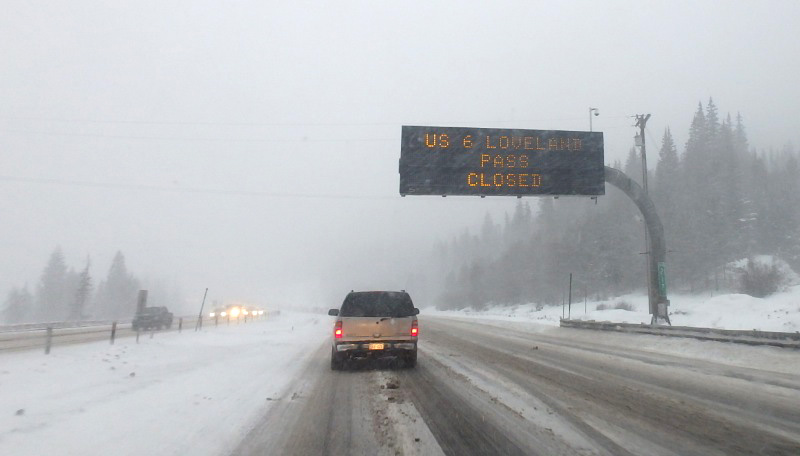
 As I slowly proceeded west on Interstate 70, signs flashed overhead. Amidst the flying snowflakes, flashing yellow words warned motorists, “Passenger Traction Law in Effect”. I racked my brain to figure out what this meant. Since I was driving my Subaru Forester with snow tires, I figured I was ok. But judging from the Toyota Camry with Wisconsin license plates, slipping and sliding in front of me, I’m guessing many others don’t either.
As I slowly proceeded west on Interstate 70, signs flashed overhead. Amidst the flying snowflakes, flashing yellow words warned motorists, “Passenger Traction Law in Effect”. I racked my brain to figure out what this meant. Since I was driving my Subaru Forester with snow tires, I figured I was ok. But judging from the Toyota Camry with Wisconsin license plates, slipping and sliding in front of me, I’m guessing many others don’t either.
It’s been more than two years since the Colorado legislature passed the “Traction Law” and I still don’t know what it means. I know it was passed in an attempt to lessen accidents on I-70 over Loveland Pass and Vail Pass. In the ten years I have lived in Colorado, accidents, not excessive snow pack, are the main reason the highway closes. I spent four hours sitting at a coffee house in Vail waiting for accidents to be cleared on the pass one lovely March day. Colorado Department of Transportation (CDOT) does an amazing job of keeping the highway clear during even the biggest snowstorms.
So what exactly is the “Traction Law”?
According to CDOT’s information sheet, it means this:
Traction Law (Code 15) — Use George’s Head to Check Your Tread
• If weather conditions require, CDOT will implement a Traction Law.
• Under a Traction Law, motorists will need to have either snow tires, tires with the
mud/snow (M+S) designation, or a four-wheel/all-wheel drive vehicle — all tires
must have a minimum one-eighth inch tread.
The problems I have with the Traction Law are many. One, how would the average driver know what it meant by “Traction Law”? I sincerely hope that said driver is not going to do a quick Google search on their smart phone while navigating snow packed roads on the interstate.
Two, what about the number of people driving through Colorado on I-70 from points east (Kansas, Missouri, Indiana, Ohio) to points west that are not in the mountains (western Colorado, Utah, Las Vegas)? Are they really going to make sure they have snow tires on their car for the 150 miles through the mountains of Colorado? Will they really have checked their tread to make sure it is at least one eighth deep? Should they be expected to spend an extra night in Denver, so they are not in violation of the traction law?
Three, I doubt the Traction Law does much good in regard to the intended effect of lessening accidents on the I-70 high elevation passes. The truth is most cars come with all-season tires that are rated mud and snow (M+S). I had M+S tires on my all wheel drive Subaru Forester our first winter here in Nederland and managed to slide off the Eldora Ski Resort access road. So much for Mud and Snow.
Finally, who exactly is enforcing this law? Today, during my several hours on the highway driving to and from Copper Mountain, I saw one policeman who was tending to an accident on the side of the road. I didn’t see a single authority checking compliance of this supposed law.
Having lived in Lake Tahoe for several winter, I think Colorado should take a cue from the Cal Trans folks. If you want to get serious about lessening accidents, require all 2-wheel drive cars to chain up for adverse road conditions with snow and ice. And require 4-wheel drive to have snow tires. And actually have someone at a check point to ensure compliance.
Otherwise, scrap the traction law altogether and acknowledge it is just a bunch of words meant to make it seem like the someone in Colorado’s state legislature is doing something to keep our roads open and safe during the winter.

